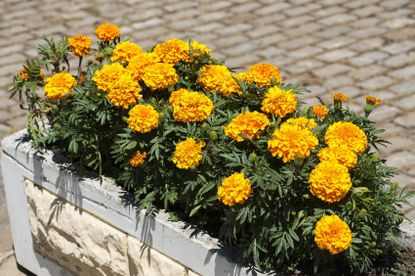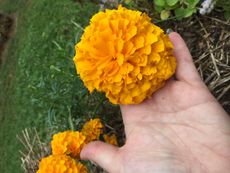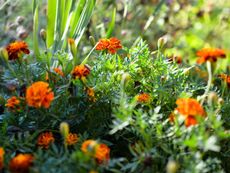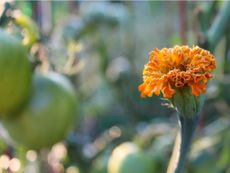Caring For Marigolds In Pots – Tips On Growing Marigolds In Containers


Marigolds are easygoing plants that bloom reliably, even in direct sunlight, punishing heat and poor to average soil. Although they are beautiful in the ground, growing marigolds in containers is a surefire way to enjoy this delightful plant. Read on to learn how to grow marigolds in containers.
Potted Marigold Plants
Any type of marigold can be grown in containers, but keep in mind that some types, such as African marigolds, can reach heights of up to 3 feet (1 m.) and may be too large for standard containers. Most gardeners like to plant smaller container grown marigolds. For example, French marigolds are small, bushy plants that reach heights of only 6 to 18 inches (15 to 20 cm.), depending on the variety. They are available in orange, yellow, mahogany or bicolor, and in double or single blooms. Signet marigolds are another good choice for potted marigold plants. The bushy plants have attractive, lacy foliage and orange, yellow or rusty red blooms.
Caring for Marigolds in Pots
Don’t crowd potted marigold plants, as healthy marigolds require plenty of air circulation. One marigold is enough for a 6-inch (15 cm.) pot, but you can grow two or three in a 12-inch (30 cm.) pot, and five or more small plants in a large container with a diameter of 18 inches (45 cm.). Be sure the container has a drainage hole in the bottom. Use a good quality, lightweight potting mix. A handful of sand, perlite or vermiculite improves drainage. Place the pot where the marigold is exposed to at least six hours of sunlight. Water the marigold when the top 1 to 2 inches (2.5 to 5 cm.) of soil is dry. Water deeply, then let the soil dry before watering again. Never allow the soil to remain soggy, as wet conditions invite root rot and other moisture-related diseases. Pinch the tips of newly planted marigolds once or twice to encourage bushy plants. Deadhead the plants regularly to trigger new blooms. Apply a water-soluble fertilizer every month, but don’t over-fertilize. Too much fertilizer or overly rich soil can produce weak plants with few blooms.
Gardening tips, videos, info and more delivered right to your inbox!
Sign up for the Gardening Know How newsletter today and receive a free download of our most popular eBook "How to Grow Delicious Tomatoes."

A Credentialed Garden Writer, Mary H. Dyer was with Gardening Know How in the very beginning, publishing articles as early as 2007.
-
 Urban Composting Guide: How To Compost In The Middle Of The City
Urban Composting Guide: How To Compost In The Middle Of The CityUrban composting does not have to be daunting. You can compost in the city, and maybe even try some urban worm composting!
By Mary Ellen Ellis
-
 Shrub Diseases And Pests To Watch Out For
Shrub Diseases And Pests To Watch Out ForShrub diseases and pests can be challenging. Learn how to recognize and eradicate them before they can present a danger to your plants.
By Susan Albert
-
 Marigold Flower Uses: Marigold Benefits For Gardens And Beyond
Marigold Flower Uses: Marigold Benefits For Gardens And BeyondMarigolds are appreciated primarily for their beauty, and you may not have considered the many surprising marigold benefits for gardens. Click on the following article to learn about ways to use marigold plants in the garden.
By Mary H. Dyer
-
 Marigold Vs. Calendula – Difference Between Marigolds And Calendulas
Marigold Vs. Calendula – Difference Between Marigolds And CalendulasIt’s a common question: Are marigold and calendula the same? The simple answer is no. Although both are members of the sunflower family, marigolds and calendula are plants with different genera. Why all the confusion? Find out in this article and how to tell them apart.
By Mary H. Dyer
-
 Mountain Marigold Care – How To Grow Bush Marigold Plants
Mountain Marigold Care – How To Grow Bush Marigold PlantsA beautiful annual scene is caused by the fall bloom period of Mountain Lemmon marigolds, which may also bloom sporadically in spring and summer, but save their best display for autumn. Click on this article to read more about mountain marigold plants.
By Darcy Larum
-
 African Marigold Care: How To Grow African Marigolds
African Marigold Care: How To Grow African MarigoldsAfrican marigolds were sacred to the Aztecs, who used them as a medicine and as a ceremonial offering to the sun gods. Marigolds are still called the herb of the sun because of this. Click this article for more African marigold information.
By Darcy Larum
-
 Deadheading Marigold Plants: When To Deadhead Marigolds To Prolong Blooming
Deadheading Marigold Plants: When To Deadhead Marigolds To Prolong BloomingShould you start removing spent marigold flowers? Marigold deadheading does help keep the garden looking its best and encourages new blooms. Click on this article for more information about deadheading marigold plants.
By Teo Spengler
-
 Marigold Leaf Problems: Treating Marigolds With Yellow Leaves
Marigold Leaf Problems: Treating Marigolds With Yellow LeavesMarigold blossoms are a bright, sunny yellow, but the foliage below the flowers is supposed to be green. If your marigold leaves are turning yellow, you've got marigold leaf problems. To learn what might be causing yellowing marigold leaves, click here.
By Teo Spengler
-
 Using Marigolds Around Plants – Do Marigolds Keep Bugs Away
Using Marigolds Around Plants – Do Marigolds Keep Bugs AwayDo marigolds keep bugs away? The best way to find out is to experiment in your own garden, and you really can't go wrong. There's no doubt they attract a variety of beneficial insects that prey on bad bugs. Learn more about marigold plants and pests here.
By Mary H. Dyer
-
 Marigold And Tomato Companion Planting: Do Marigolds And Tomatoes Grow Well Together
Marigold And Tomato Companion Planting: Do Marigolds And Tomatoes Grow Well TogetherMarigolds are appreciated for much more than their beauty; marigold and tomato companion planting is a tried and true technique used by gardeners for hundreds of years. What are the benefits of growing these together? Click here to find out.
By Mary H. Dyer